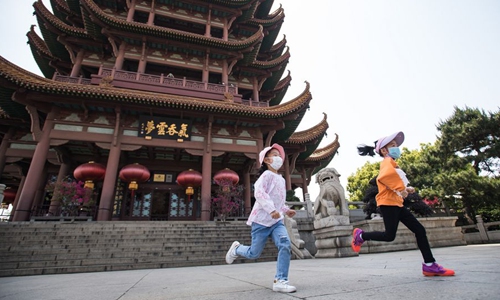
Tourists visit the Yellow Crane Tower in Wuhan, central China's Hubei Province (Xinhua/Xiao Yijiu)
Central China's Hubei Province, one of the novel coronavirus (COVID-19) hardest-hit regions in China, saw a sharp year-on-year decline of tourists during this year's May Day holidays although its capital city Wuhan had been chosen as a top destination by some domestic visitors.Only 109,664 tourists visited Hubei's 22 reopened key scenic areas on Friday - the first day of the five-day vacation From May 1 to 5 - a dramatic 86.97 percent year-on-year decrease.
The 22 scenic areas generated a total of 6.79 million yuan ($961,729) of tourism revenue on Friday, a 95 percent year-on-year plummet, reported the Xinhua News Agency, citing figures released by the Hubei Culture and Tourism Administration.
Just three days ahead of May Day holidays, Wuhan was ranked as the top domestic travel destination, according to a survey of 15,163 questionnaires released by the Tourism Research Center under the Chinese Academy of Social Sciences on April 28. The report had been echoed by many Chinese on social media.
Nonetheless, contrary to the interest that people had expressed online for Wuhan, few have seemed to have really traveled there in this vacation.
Some hesitated tourists told the Global Times that they feel it is not yet the "best time" to go there as they worry about the possible risks of infection - although Wuhan has reported zero in-hospital COVID-19 patients on April 26.
Wen Zhe, a tourist who initially planned to visit Wuhan during the May holidays, changed his destination to Xi'an in Northwest China's Shaanxi Province. "I like Wuhan, but I think it is safer to go there after some time," he said.
Wuhan's landmark Yellow Crane Tower served only 1,595 visitors on Friday, only accounting for 3 percent of those in the same period last year, said the scenic area's staff.
The number was much fewer than the daily limit of 5,400 visitors the tower has set for the vacation. "It is basically in line with our expectations," Jiang Meng, a publicity staffer with Yellow Crane Tower management office, told the Global Times on Saturday.
Liu Shanliang, a 57-year-old visitor who had been to the tower on Friday, said he only saw a few tourists when entering the scenic area around 10:30 am. "There were neither crowds nor queues," he told the Global Times.
Another visitor surnamed Wu, a Wuhan local resident, said to the Global Times that he saw approximately 100 people in this scenic area on Friday.
"The tower was quiet, different from the busy and lively scene I experienced (in the same vacation) last year," he recalled.
Others didn't choose Wuhan because they were reluctant to bring added virus-control pressure to the city. "Wuhan has made a lot of efforts to fight the virus," one said. "I don't want us tourists to threaten the local situation."
It is understandable Wuhan hasn't seen many tourists in this vacation as the epidemic has not come to a final end, Wu said. He estimated that visitors will largely increase months later, especially during this year's National Day vacation in October.
Similar to Wuhan's Yellow Crane Tower, some other key scenic areas in Hubei reached by the Global Times on Saturday also said they had a tremendous decline in tourists. Many scenic areas have limited the daily visitor number under 30 percent of their largest carrying capacity to avoid possible risks of virus transmission, but the actual tourists they served on Friday were far fewer than the limit.
Visitors to the Wudang Mountain in Shiyan city, known as cradle of the Taoist culture, decreased by over 80 percent year-on-year, said a staffer with the scenic area surnamed Chen. "The majority of the visitors were Hubei locals," Chen said.
The Longzhong scenic area in Xiangyang city, one of China's 5-A (the highest level) tourist attractions, saw 5,500 visitors on Friday, with more than an 80-percent year-on-year drop as well.
The falloff is not surprising, said director of Longzhong's publicity department surnamed Zhao. "We have expected this," Zhao told the Global Times, adding that he believes the decline won't last long as the local epidemic situation continues to improve.
Hubei is gradually recovering from the pains caused by the deadly virus. There have been no new COVID-19 cases across the province for 29 consecutive days since April 4.
To boost local tourism, the Hubei government released a notice on Friday that contains policies including allocating 100 million yuan to support tour companies and encouraging a 2.5-day weekend.

